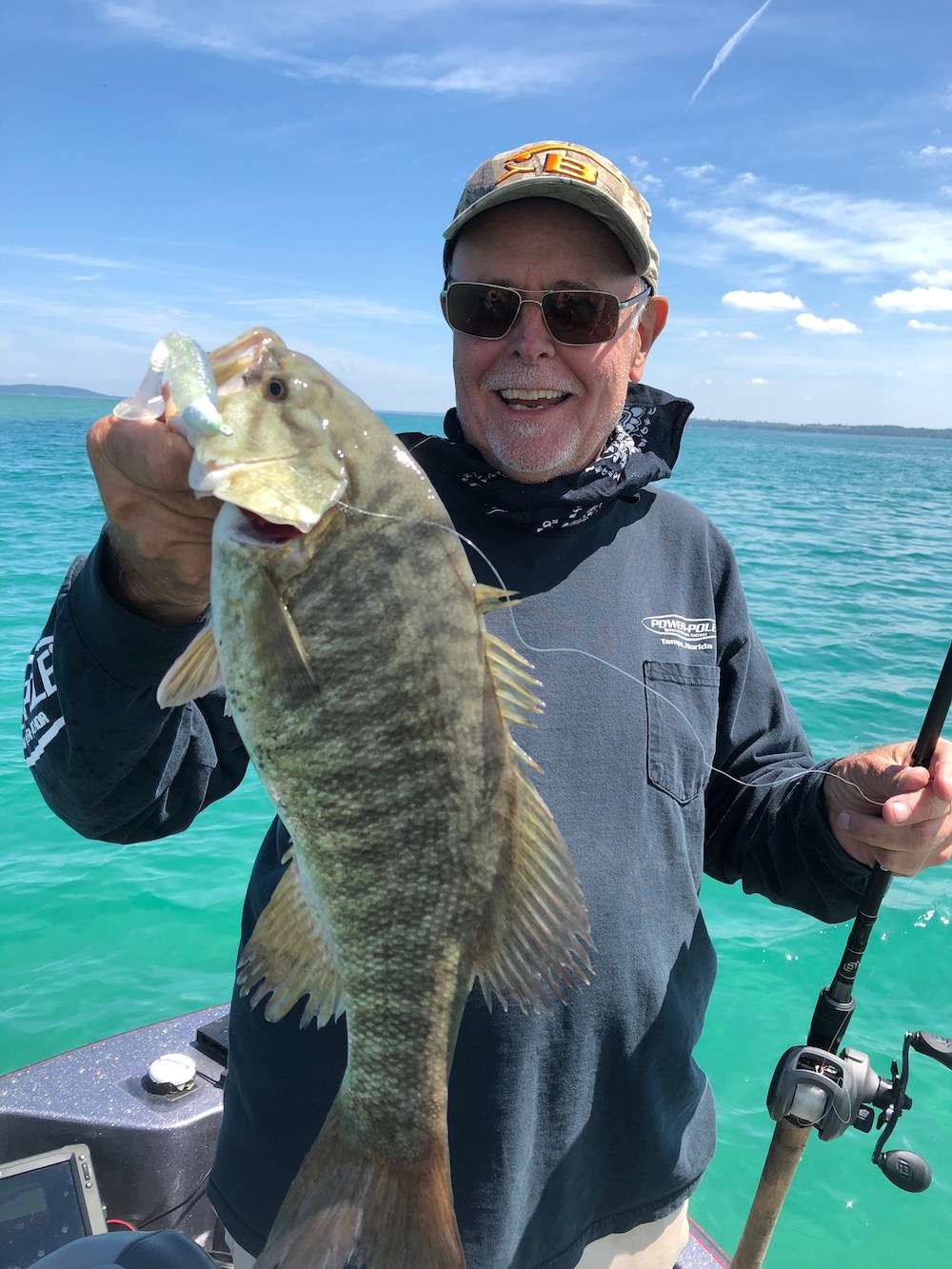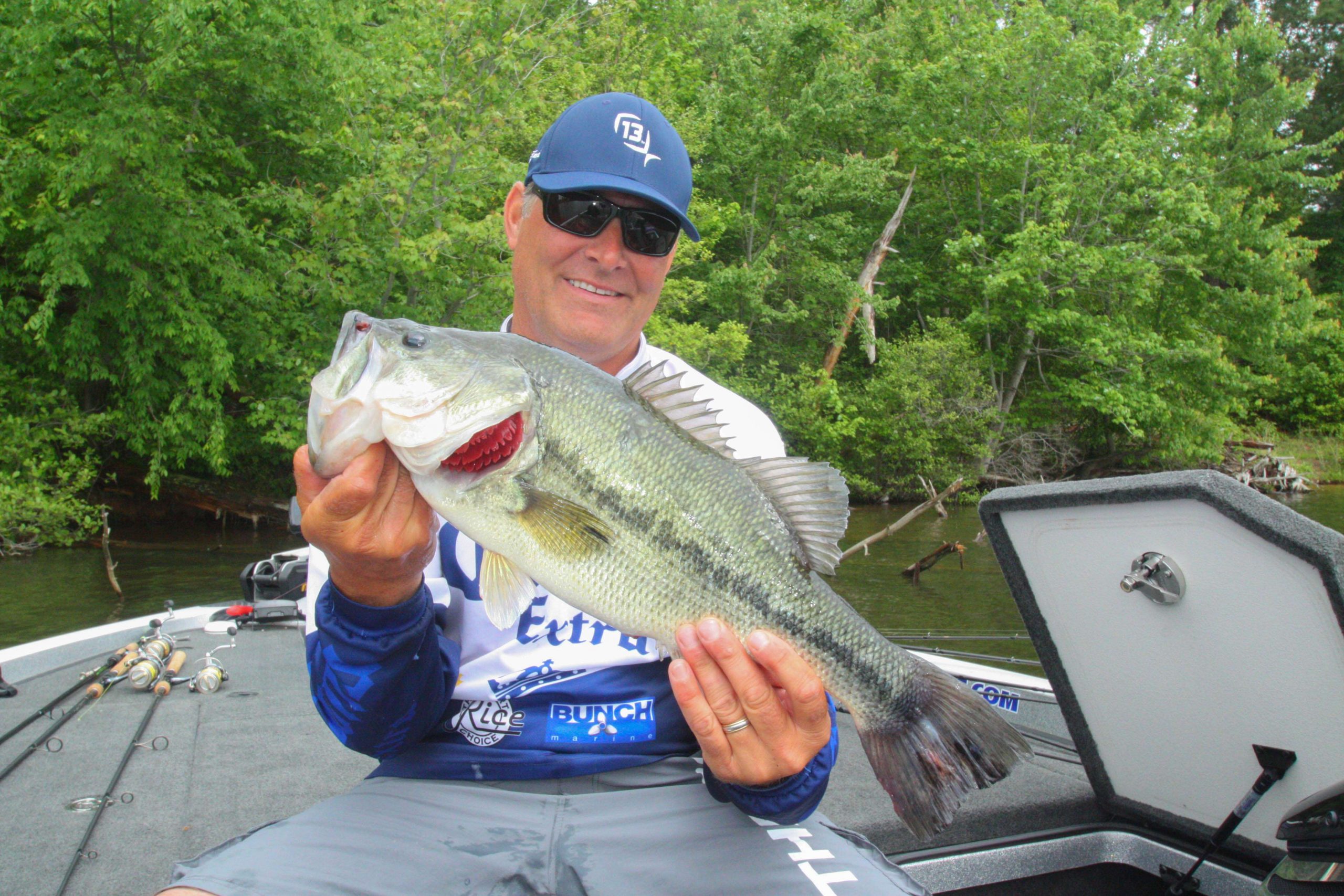
Fishing the postspawn can be one of the most frustrating times on the water. The fish are tired and lethargic from the rigors of making babies, and are often in no mood to eat or react to lures. This is precisely what Elite Series pro Brandon Coulter faced on his early May outing. And to make matters worse, a little cold front had moved through the area. Although Coulter has only been fishing the Elite series for a couple years, he is a veteran tournament angler and has faced these challenging conditions often. What follows is a master’s class on targeting post-spawners, his decisions were perfectly timed and the results profound. Commit his actions to memory and the next time you face these two negatives, a very positive result will follow.
6:29 a.m. It’s cloudy, damp and chilly when Coulter and I arrive at Lake L and prep the Ranger for launching.
7 HOURS LEFT
6:45 a.m. Coulter’s boat hits the water. He checks Lake L’s surface temp: 67 degrees. “It’s been rainy and unseasonably cool here the past few days, and I bet the water has chilled down from the 70s,” he says. “There are probably some bass on bed and others that have already spawned. Hopefully, there’s a shad spawn going on; this can trigger a good bass bite.” He breaks out an arsenal of 13 Fishing rods and reels and arranges them on the Ranger’s front deck.
6:52 a.m. Coulter drops his trolling motor and makes his first casts to a riprap bank near the launch ramp with a vintage Bomber Long A floater-diver minnow. It wobbles across the surface as he retrieves it, throwing a wake reminiscent of an injured shad. “This old plug used to be silver but most of the paint has been chewed off it.”
7:03 a.m. Coulter moves to Lake L’s earthen dam and casts a black and white River2Sea Whopper Plopper surface plug parallel to the structure. “The water is real choppy here from that north wind, which is why I’m switching to this big, noisy plug. It has a finned tail that spins on retrieve, creating some serious surface commotion.”
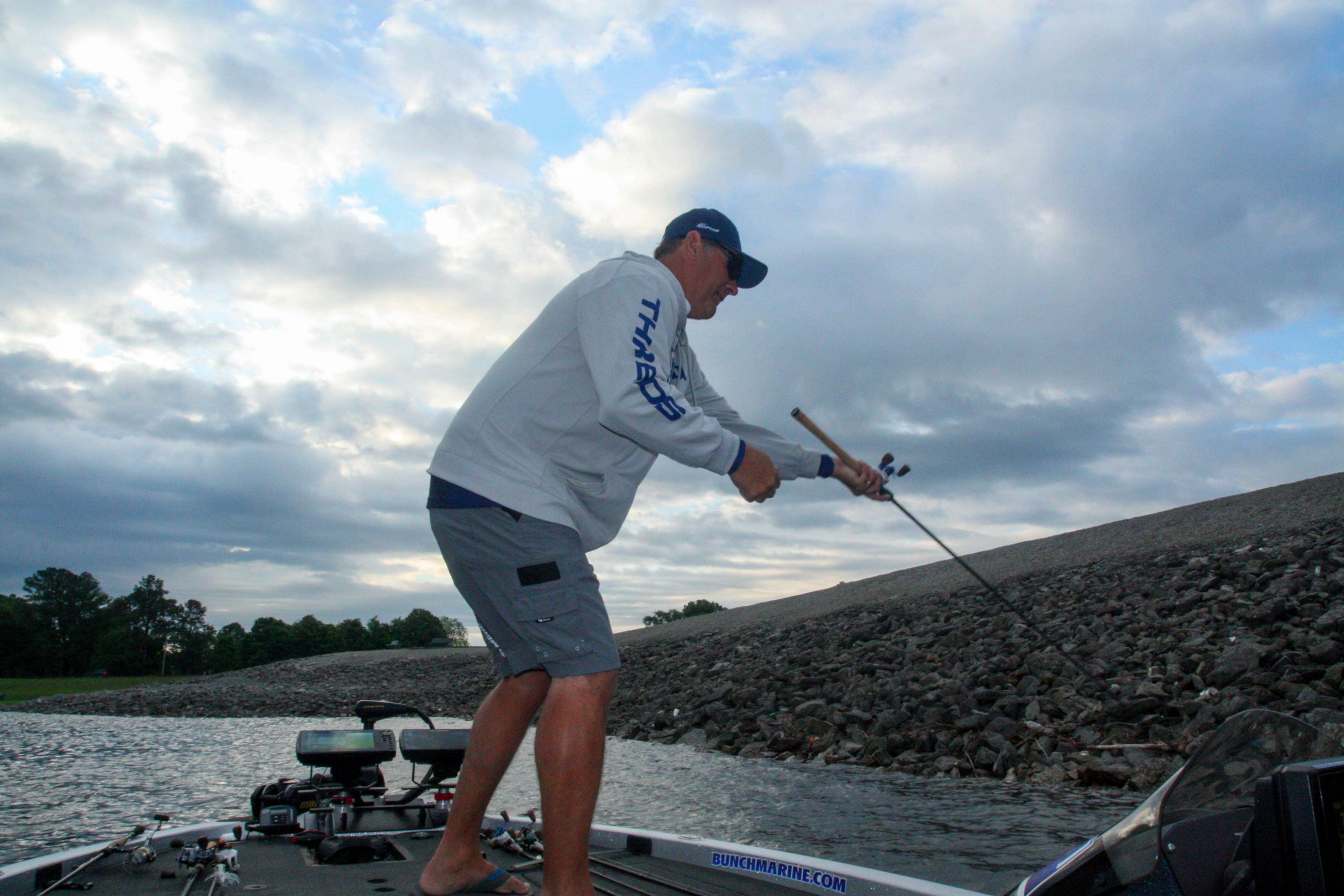
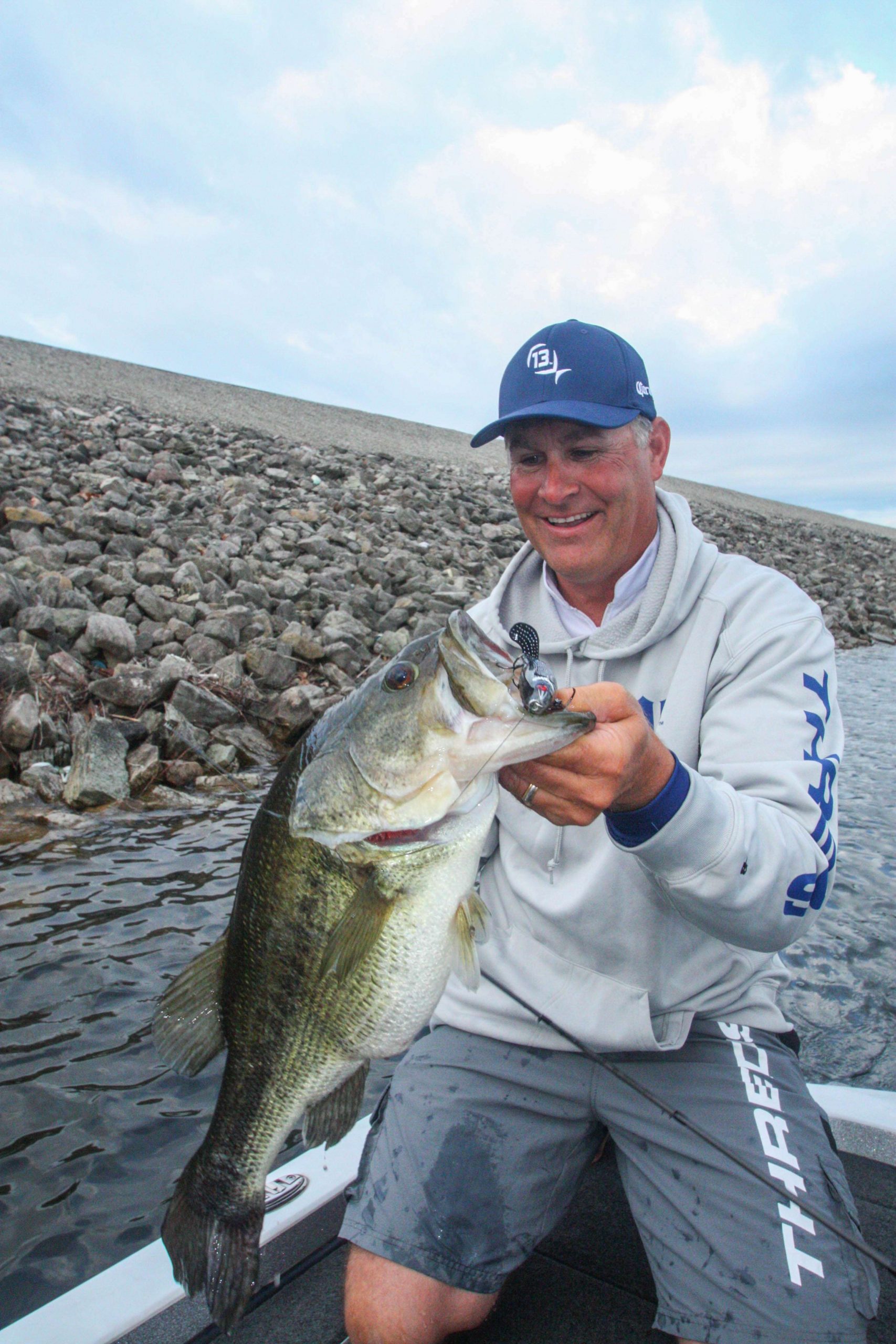
7:05 a.m. Coulter gets a massive strike on the Whopper Plopper! The lunker bass surges for deeper water. Coulter races to the Ranger’s rear deck, drops to his knees and grabs his first bass of the day, a hulking largemouth weighing 7 pounds, 13 ounces. “Unbelievable! This fish hit right at the boat, a half-cast off the bank, so it either followed the Plopper out from the riprap or it was suspending out here in open water. Judging from its location near deep water and its beat-up tail, I’d say this is a postspawn fish.”
7:10 a.m. Coulter has reached the far end of the dam. A small bass nips at the Whopper Plopper but doesn’t hook up. “What was that little guy thinking? He’s way smaller than the lure!”
7:15 a.m. Coulter moves to the entrance of a nearby cove, where he retrieves the Plopper around a sea wall. “I’ve found for some unknown reason, man-made structures often attract more postspawn bass than natural cover does.”
7:18 a.m. He moves into the cove and pitches a black-and-blue Reaction Innovations Sweet Beaver creature to a dark spot on the bottom near the wall. “Depending on the lake’s bottom composition, a bass bed can either appear as a dark or a light patch on the bottom. If that’s a bed, I don’t see any fish on it. It’s cloudy and the lake has a tannic stain; I’m wearing Costa Del Mar sunglasses with amber lenses under these conditions.”
7:24 a.m. Coulter casts the Whopper Plopper to a seawall. A big bass explodes on it but doesn’t hook up. “I saw that fish; it was at least 6 pounds! This wall is located at the exit of a shallow spawning cove.”
7:29 a.m. Coulter runs across the lake to a rocky point. He casts the Long A and Whopper Plopper to the structure.
7:36 a.m. The sun is trying to pop through the clouds as Coulter moves to another seawall to fish a ghost shad Megabass Vision 110 jerkbait. “Most guys only use jerkbaits in cold water, but bass will smoke ’em in postspawn.”
6 HOURS LEFT
7:48 a.m. Coulter is staying a good distance off the dam as he retrieves the jerkbait with aggressive snaps of his rod. “You can fish a jerkbait much faster in 70-degree water than you can in 45-degree water.”
8 a.m. Coulter switches to a well-worn Rebel Pop-R surface plug. “This one is even more chewed up than that Long A I was using!”
8:06 a.m. He moves into a shallow cove to try the Pop-R around a grass point. A small bass nips at the plug. “During postspawn, I like to fish a Pop-R where I might fish a jig — around grass, laydowns and docks. I’ll pitch it underhand for a soft landing, then let it sit on the surface a couple seconds before popping it. If a bass is there, they’ll usually hit it.”
8:09 a.m. Coulter spots a big bass cruising near a moored pontoon boat. He peers into the murky water and spots a bed. “There’s a 4-pound male on the bed, and that big female is just circling around,” he says. He lowers his Power-Poles and pitches a white Zoom Speed Craw to the nest.
8:14 a.m. Coulter is trying to entice a bite by shaking the Speed Craw on the bed. “Neither of those fish are glued to the bed; they’re just cruising around it. The female is 7 or 8 pounds. I just bumped her with the craw, but she swam off.”
8:18 a.m. Coulter switches to a Mission Fish boot-tail swimbait and retrieves it slowly across the bed. No takers. “I wrapped a few SuspenStrips [lead tape pieces] around the lure’s belly hook to get it to swim deeper.”
8:22 a.m. No luck with the spawning bass, so Coulter presses deeper into the cove, casting the swimbait to several docks. “I haven’t seen any other beds in this cove.”
8:30 a.m. A bass short-strikes the Mission Fish near a dock. Coulter reels in quickly and pitches the Pop-R to the dock. No takers.
8:38 a.m. Coulter is working his way out of the cove along the opposite shoreline, alternating between the Mission Fish and the Pop-R.
8:42 a.m. A small bass swirls on the Pop-R.
5 HOURS LEFT
8:46 a.m. Coulter hits a couple of docks at the entrance to the cove with the Long A.
8:52 a.m. Coulter pauses to rig up a watermelon/red flake Yamamoto Senko wacky style (with a small hook through the lure’s midsection) and a green pumpkin Zoom Trick Worm on a 3/16-ounce shaky head. “OK, let’s go yank those two big fish off that bed!”
8:57 a.m. Back near the bed, Coulter tries to get the fish “riled up enough to bite” by alternating between the wacky worm and the shaky head. It’s not working.
9:10 a.m. Coulter switches Speed Craw colors from white to chartreuse and casts the critter to the nest. Still no response from the fish.
9:14 a.m. “It’s hard to walk away from a fish as big as that female, but neither of those bass are locked onto the bed,” Coulter says. He opts to leave the fish and return to them later.
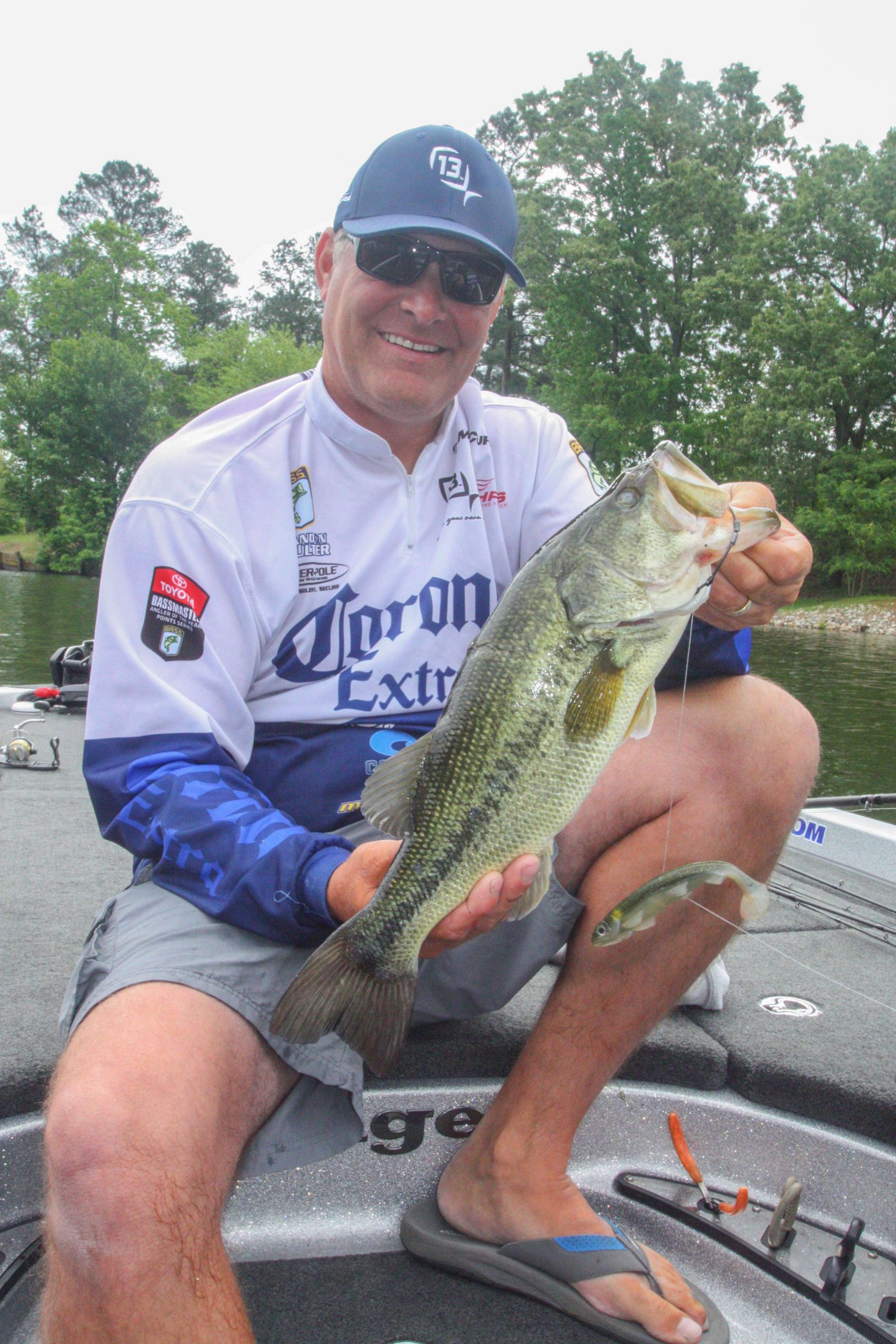
9:18 a.m. Shortly after moving from the cove to a sandy main-lake point, Coulter catches his second keeper of the day, 1 pound, 4 ounces, on the Megabass jerkbait.
9:20 a.m. Keeper No. 3, 1 pound, 12 ounces, smacks the jerkbait on the point. “I need one of those 8-pounders to hit this thing!”
9:31 a.m. Coulter has jerkbaited his way from the point to a marina cove. Here he tries the Whopper Plopper around a seawall.
9:38 a.m. He pitches the Sweet Beaver to a laydown log, but it comes back unscathed.
4 HOURS LEFT
9:45 a.m. Coulter tries the Pop-R around some shallow grass in the back of the cove.

9:48 a.m. He swims the Mission Fish past a wood pole stuck in the lake bottom. His rod bows and he swings aboard keeper No. 4, 4 pounds, 10 ounces. “This looks like a big male. I wonder if there’s a bed near that pole.” He moves closer to the stickup to check, and his hunch is confirmed.
9:51 a.m. Coulter swims the Mission Fish around the pole/bed again but can’t raise another fish. “That fish proves that bass don’t always bed right next to the bank. It was spawning by that pole three castlengths offshore.”

9:59 a.m. Coulter casts the swimbait to an empty boat slip and bags his fifth keeper, 4 pounds, 4 ounces. “I saw that fish swim out and grab it! They’ll hang around those dock floats because shad like to spawn on them.” What’s Coulter’s take on the day so far? “I’ve boated one spawning fish and four postspawners, and every fish I’ve caught so far has been a good distance off the bank. The cold front obviously hasn’t affected them too severely; so far I’ve caught fish on four totally different lure styles. I’m going to spend some more time targeting man-made structures like these boat slips and seawalls. I’ve been fishing pretty close to where we launched this morning, so I may want to run uplake and check out some areas there.”
10:05 a.m. Coulter replaces his mangled Mission Fish with a fresh one. He checks its action and fine-tunes it by adding another SuspenStrip to the hook. “There, now it’s running right. No two of these baits swim exactly alike.”
10:16 a.m. Coulter is moving methodically around the marina slips, casting, flipping or skipping the swimbait to his targets as their locations dictate.
10:22 a.m. No more action around marina structure, so Coulter moves a short distance uplake to hit several submerged trees scattered along a big flat with the swimbait. “This is the most wood cover I’ve seen so far. I’m going to key on the laydowns that are farthest off the bank for starters.”
10:27 a.m. He switches to a white 3/8-ounce Davis swim jig with a white Speed Craw trailer. “This is an awesome search lure; it’ll swim through these tree branches without hanging up, and it lets me cover water a lot faster than a flipping jig would.”
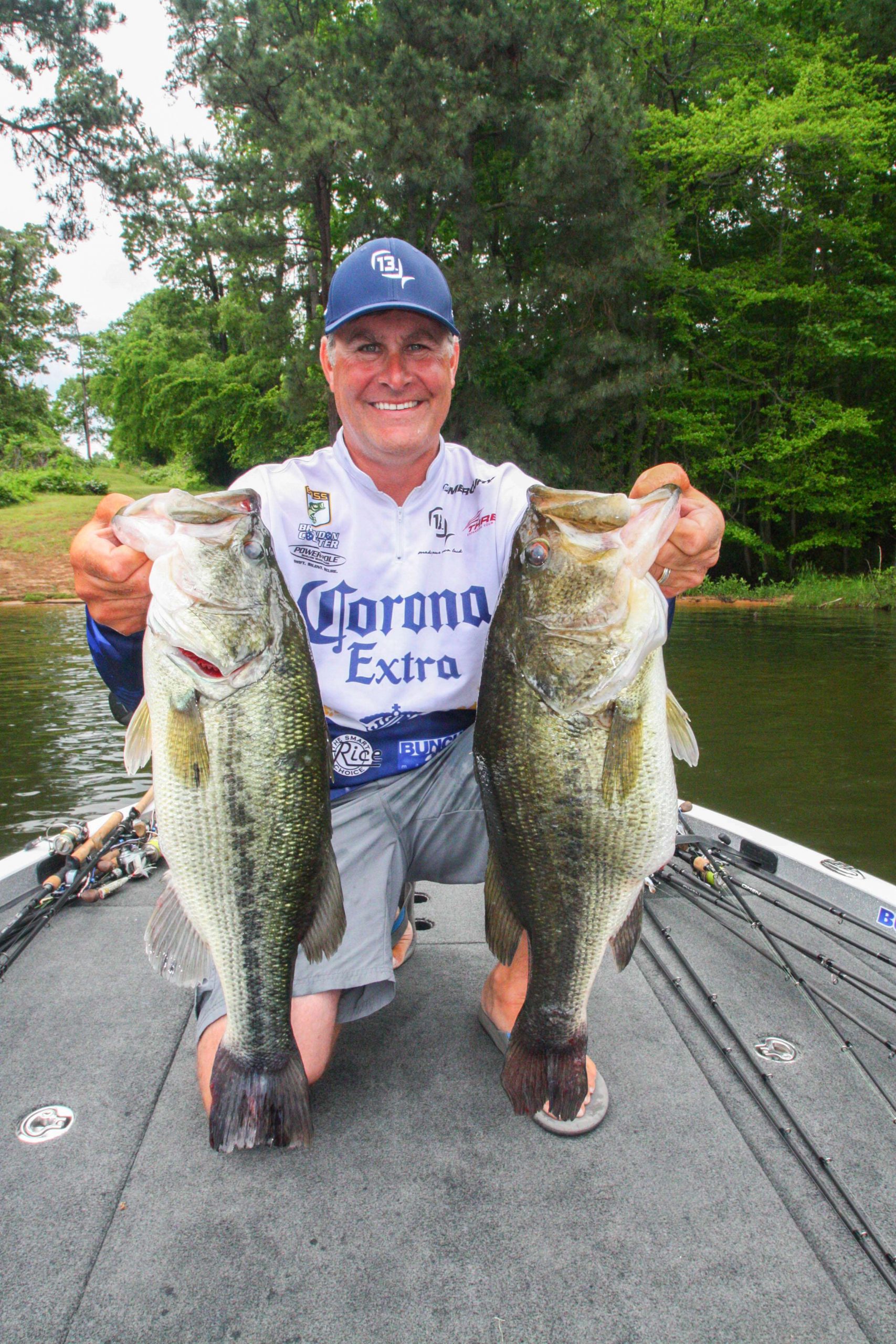
10:30 a.m. Coulter’s rod bows as a lunker bass grabs his swim jig! He works it around to the back of the boat and grabs his sixth keeper of the day, a beautiful 6-pound, 4-ounce largemouth. “The tree this fish was sitting on was sticking way off the bank. She really crushed that swim jig!” Keeper No. 6 culls the 1-4 Coulter caught earlier.
10:36 a.m. Coulter catches a 1 3/4-pound bass off another laydown on the swim jig; it’s no help to his total weight.
3 HOURS LEFT
10:47 a.m. Coulter is moving quickly uplake, hitting scattered wood cover with the swim jig.
10:56 a.m. Coulter makes an exploratory run to Lake L’s murkier upper end. Here he fishes some lily pads with a chartreuse and orange 3/8-ounce Booyah buzzbait with a Sawamura One’up Shad swimbait trailer. “The One’up Shad is the original Japanese soft swimbait. No telling how many lure companies have copied it. Before you could order them off the internet, the FLW guys used to give the Japanese co-anglers hundreds of dollars to bring boxes of these baits back from Japan.”
11:06 a.m. He tries a black Snag Proof Ish’s Poppin’ Phattie frog around the pads.
11:10 a.m. The pads don’t pan out, so Coulter moves to a nearby rock bank, where he gets a short-strike on the Pop-R.
11:12 a.m. Coulter catches a 1 1/2-pound keeper on the swim jig; no help there.
11:18 a.m. Another 1-8 keeper hits the swim jig in front of some pads; still no help.
11:27 a.m. Coulter runs back downlake to a big creek arm to fish isolated laydowns with the swim jig.
11:36 a.m. Coulter moves a quarter mile farther downlake to try the Whopper Plopper on a deep point.
11:40 a.m. He rounds the point and enters a shallow cove, where he retrieves the Long A around shoreline bushes.
2 HOURS LEFT
11:50 a.m. Coulter books it around the rest of the cove with the swim jig and Pop-R. Nothing there.
12:01 p.m. Coulter moves to a steep channel bank with multiple docks. He tries the jerkbait and swimbait without success.
12:13 p.m. He catches a short fish off a dock on the jerkbait.
12:16 p.m. Coulter races to a sloping bank terminating in a shallow point. He tries the jerkbait; it comes back clogged with slimy grass.
12:18 p.m. Coulter gets back-to-back bumps from small fish on the swim jig.
12:23 p.m. He moves into a big cove to try the Pop-R around several docks.
12:26 p.m. A bass swirls on the Pop-R. Coulter immediately casts the shaky head worm to the fish, but it’s not interested.
12:28 p.m. Coulter exchanges the shaky head worm for a green pumpkin Zoom Baby Brush Hog. “Let’s run back downlake to see if those two big fish are still on that bed I fished earlier.”
12:37 p.m. The fish are there, all right. Coulter pitches several different lures to the nest but can’t get them to bite anything.
1 HOUR LEFT
12:55 p.m. Coulter runs to a sea wall near the dam to try the jerkbait.
1:09 p.m. He moves back to the dam and tries a big Roman Made Negotiator glide bait around the riprap.
1:15 p.m. Back to the Whopper Plopper. “I need one more big fish to cull that 1-12.”
1:21 p.m. Coulter moves to a submerged rockpile, where he tries the jerkbait and Plopper.
1:29 p.m. Coulter’s time is running out. He races to the bank where he caught his 6-4 and tries the swim jig around some laydowns.
1:33 p.m. He catches a 1-3 on the swim jig; no help.
1:40 p.m. Back to the marina, where he pitches the swim jig to boat slips.
1:45 p.m. Coulter’s time is up. He’s had an awesome day on Lake L, boating 10 keeper bass, the five biggest of which weigh a hefty 24 pounds, 11 ounces.
The Day in Perspective
“The cold front evidently pulled most of the better fish off the banks today,” Coulter told Bassmaster. “The big surface plug, swimbait and swim jig accounted for most of my weight. The bite started to taper off by late morning once the fish felt the impact of the frontal passage. If I were to fish here tomorrow, I’d stay with those same lures and maybe run around the lake a little more to locate some deeper laydowns.”
Where And When Brandon Coulter Caught His Five Biggest Bass
1. 7 pounds, 13 ounces; black and white River2Sea Whopper Plopper topwater plug; open water in front of dam; 7:05 a.m.
2. 1 pound, 12 ounces; ghost shad Megabass Vision 110 jerkbait; sand point; 9:20 a.m.
3. 4 pounds, 10 ounces; Mission Fish swimbait; spawning bed; 9:48 a.m.
4. 4 pounds, 4 ounces; same lure as No. 3; empty marina slip; 9:59 a.m.
5. 6 pounds, 4 ounces; white 3/8-ounce Davis swim jig with matching Zoom Speed Craw trailer; submerged tree; 10:30 a.m.
TOTAL: 24 POUNDS, 11 OUNCES

